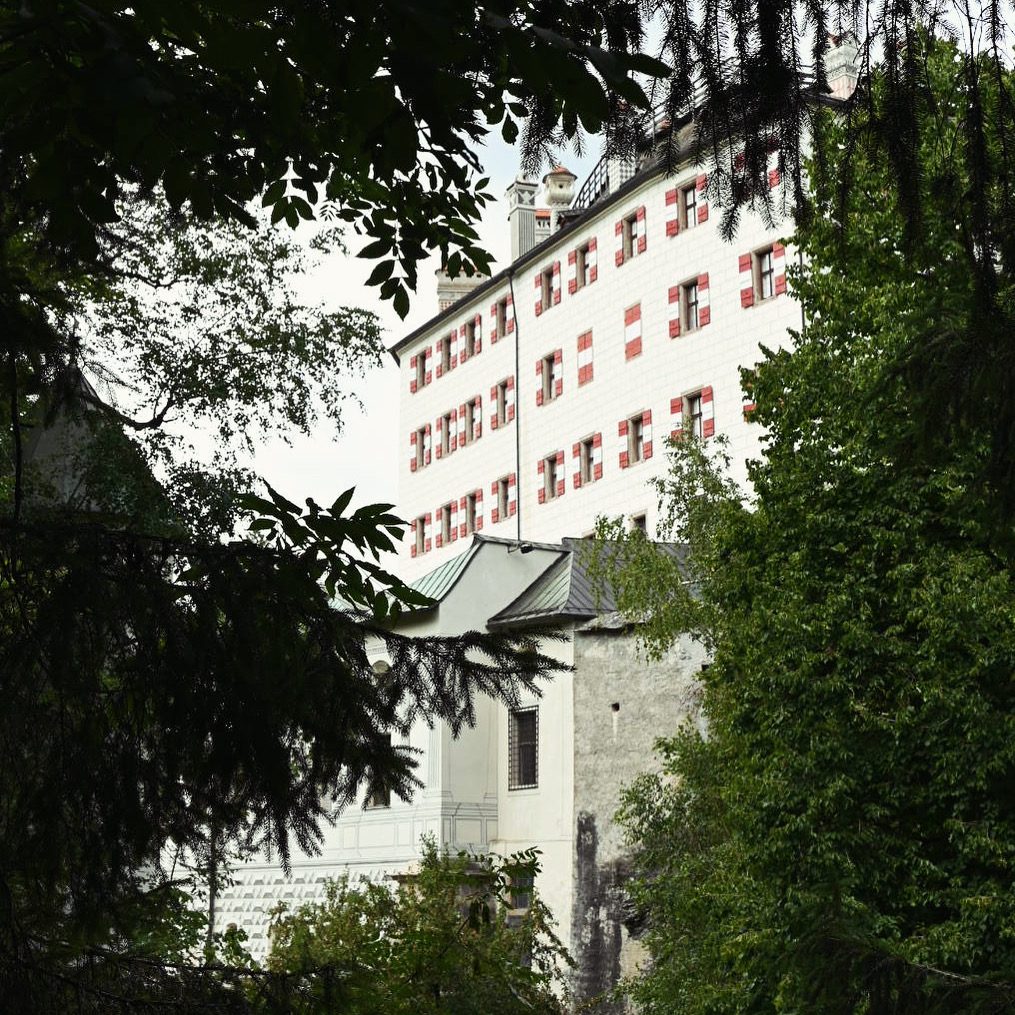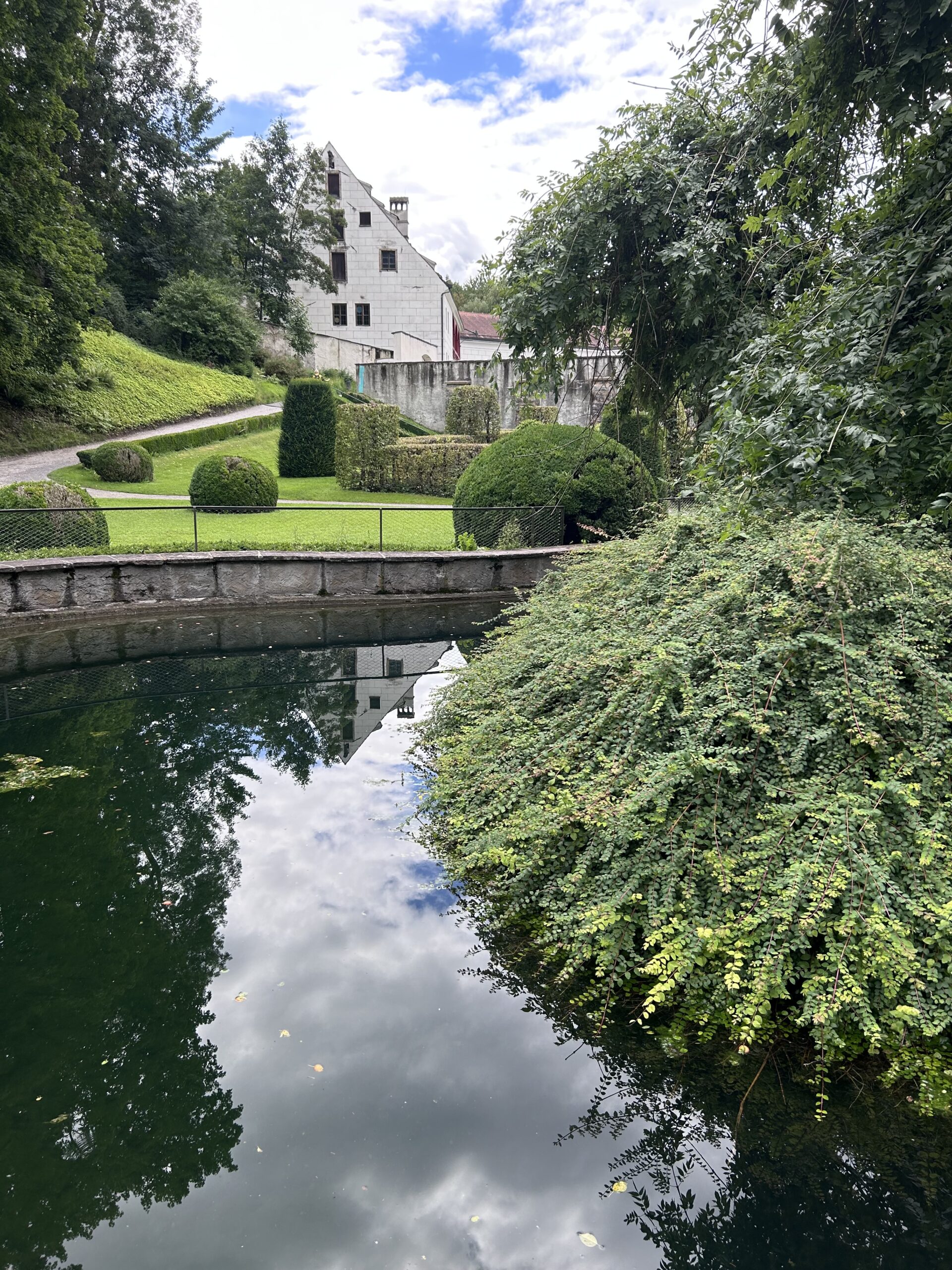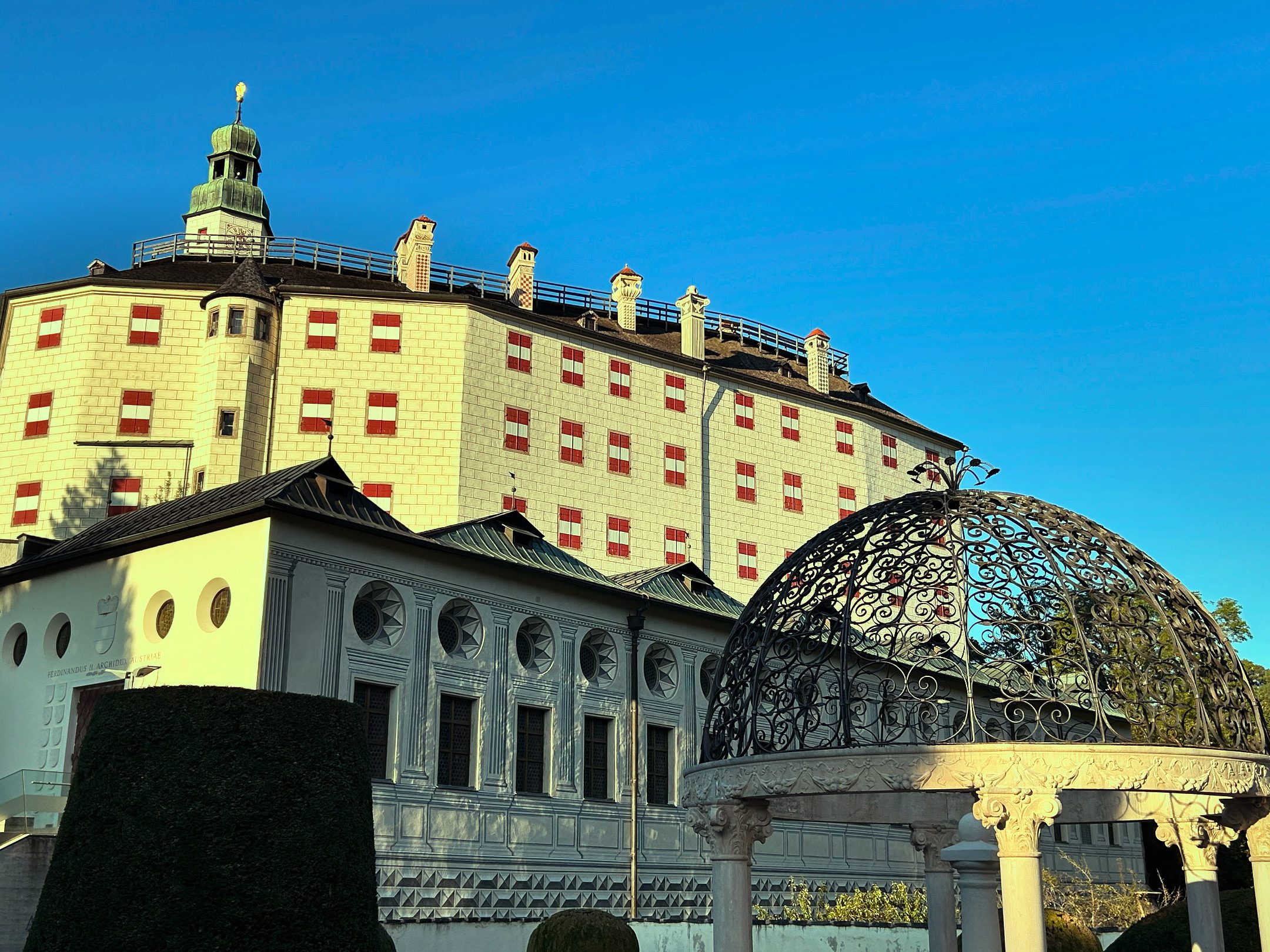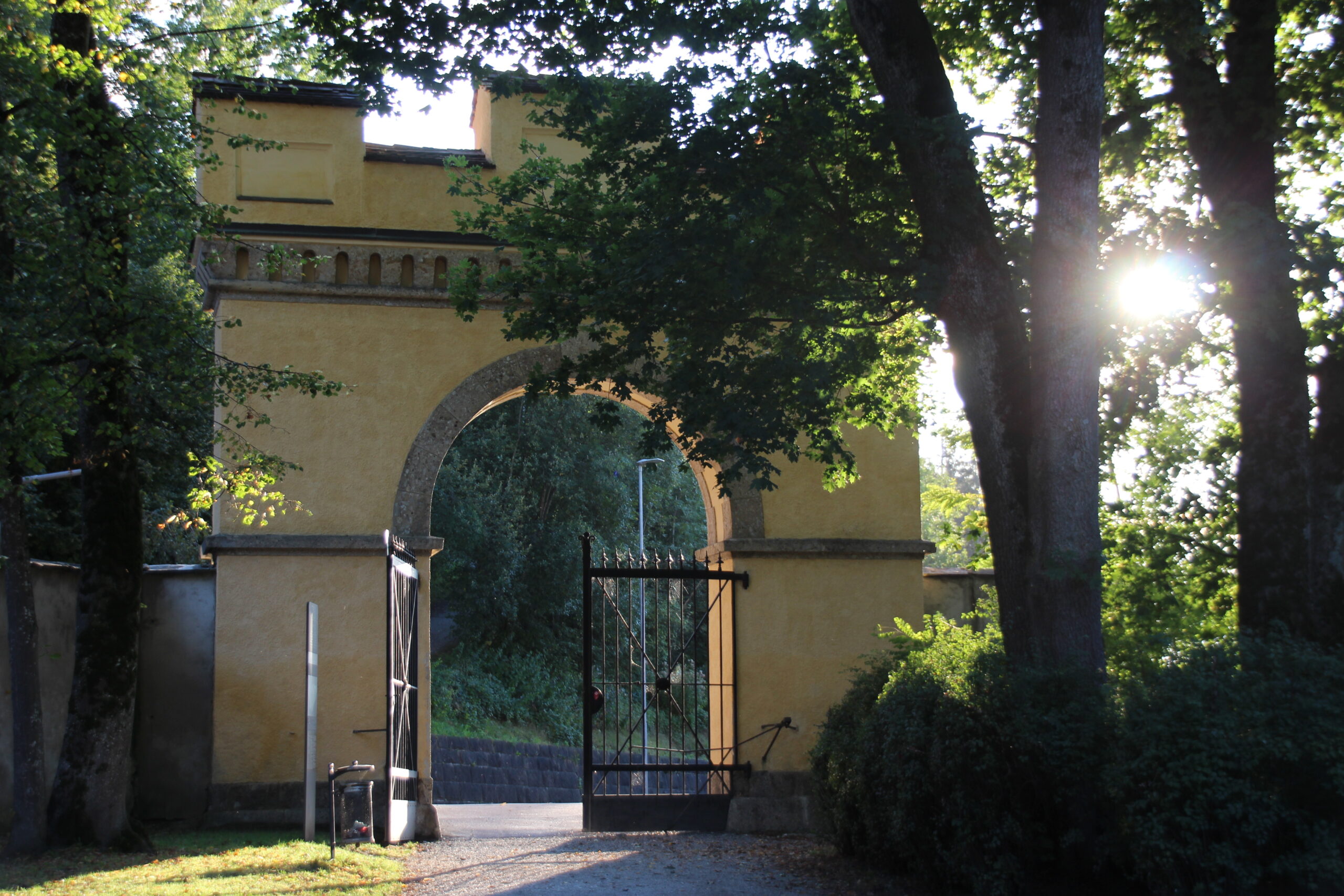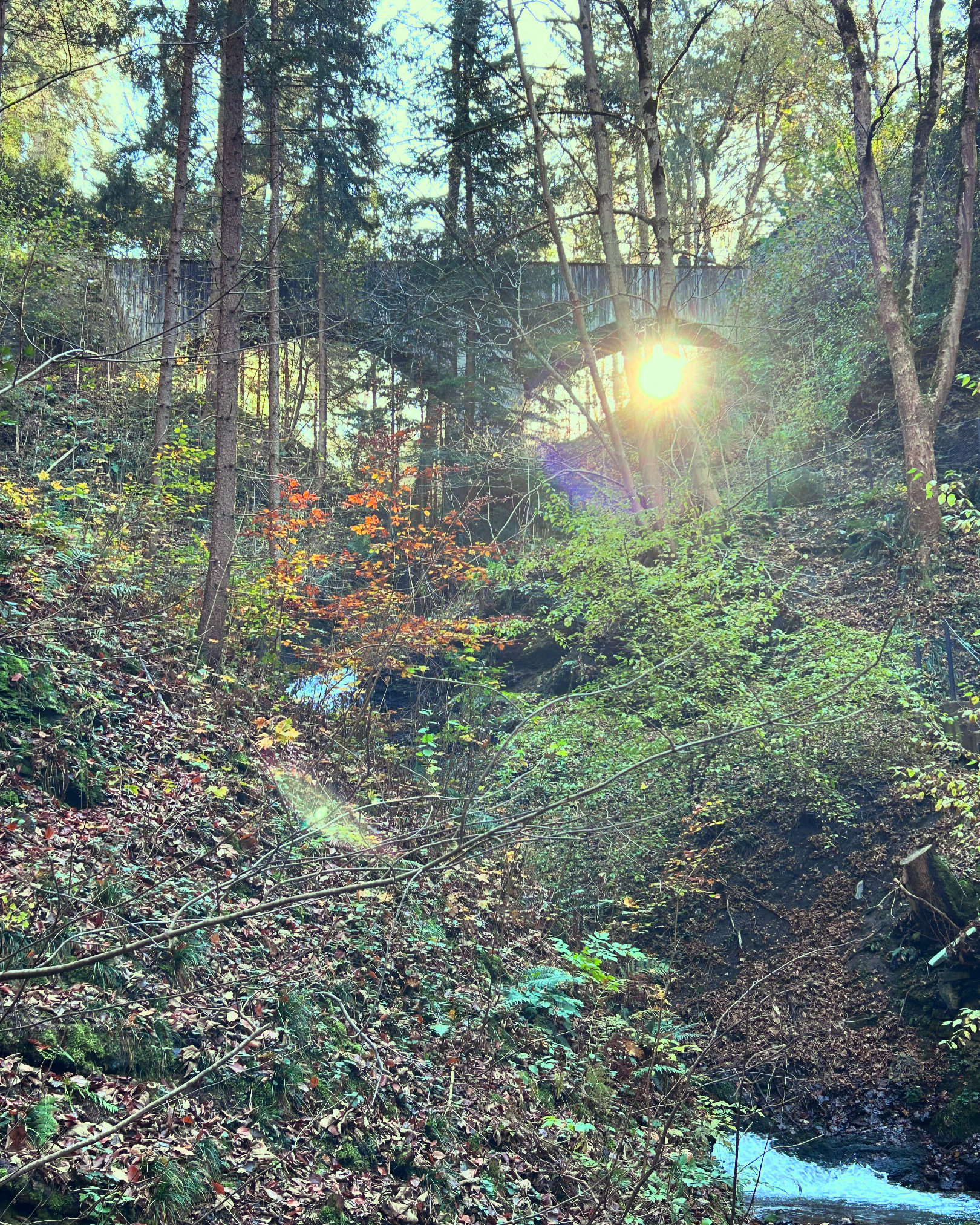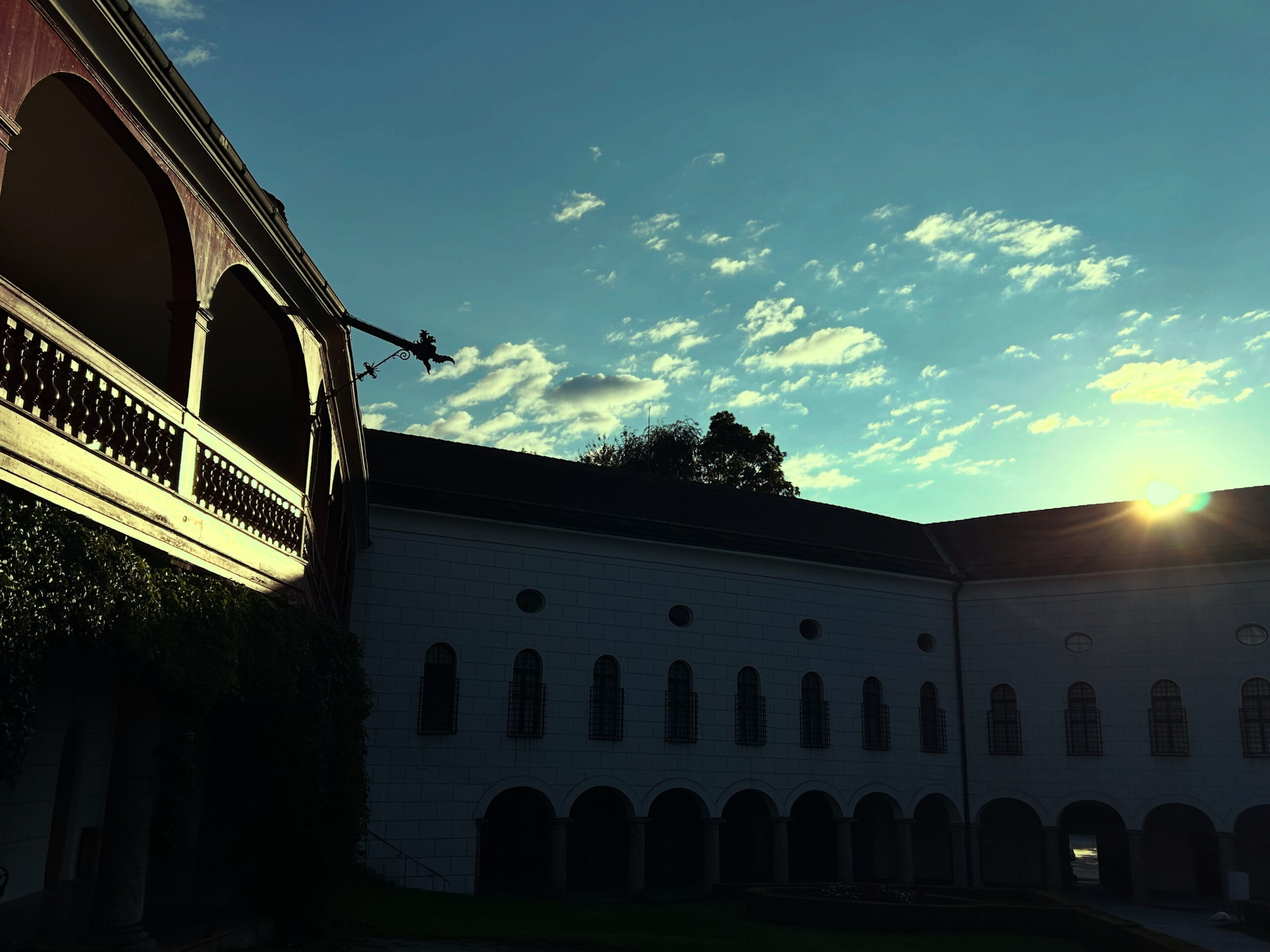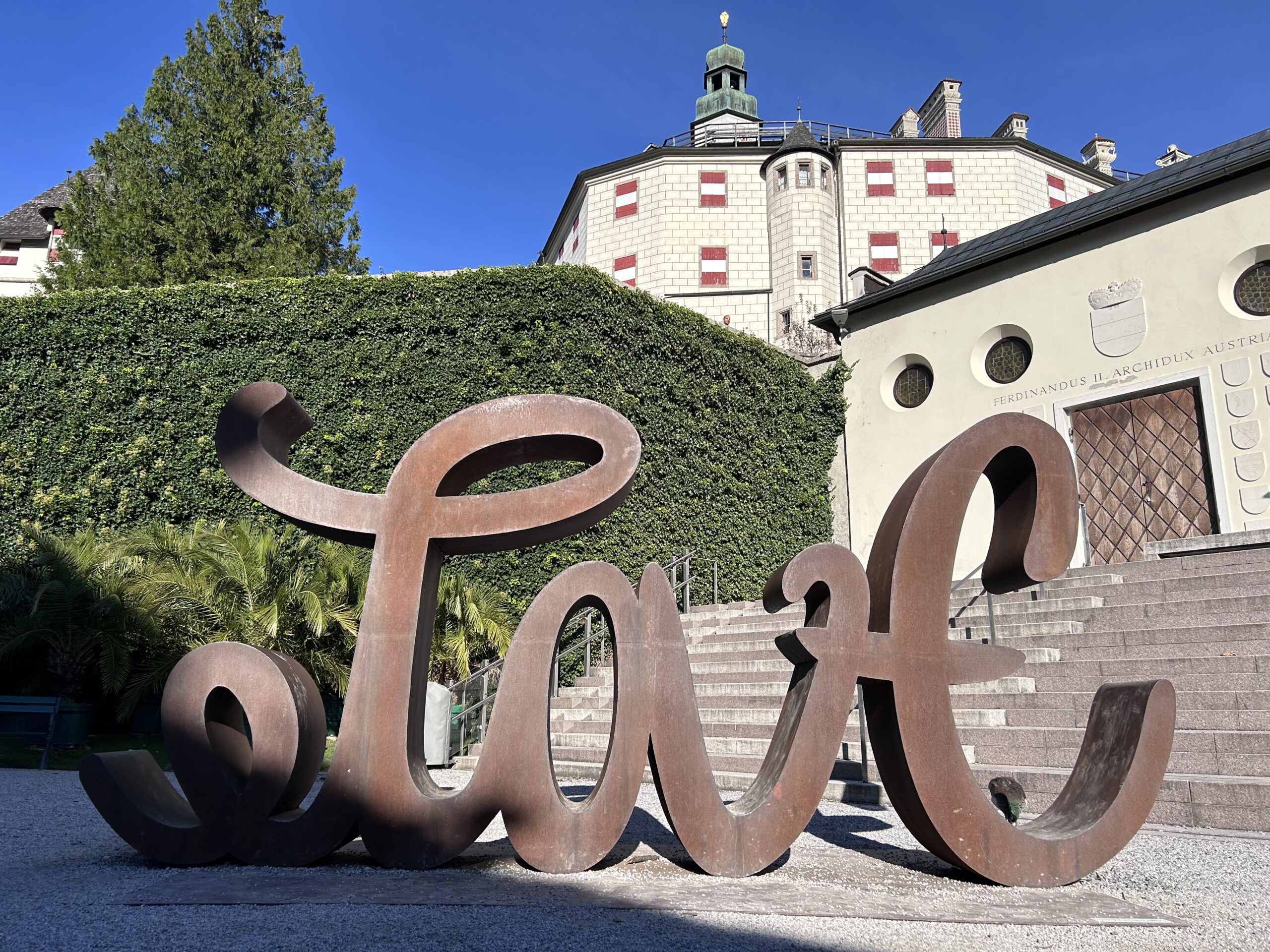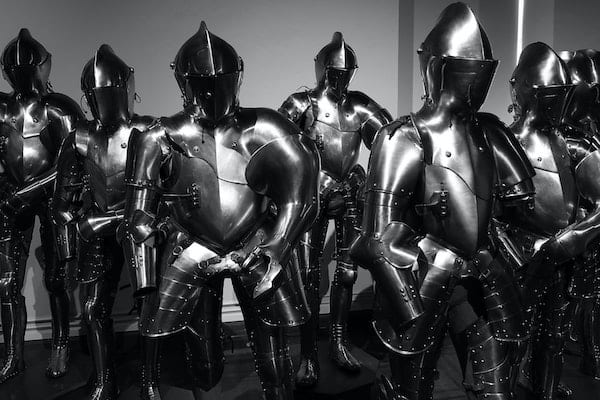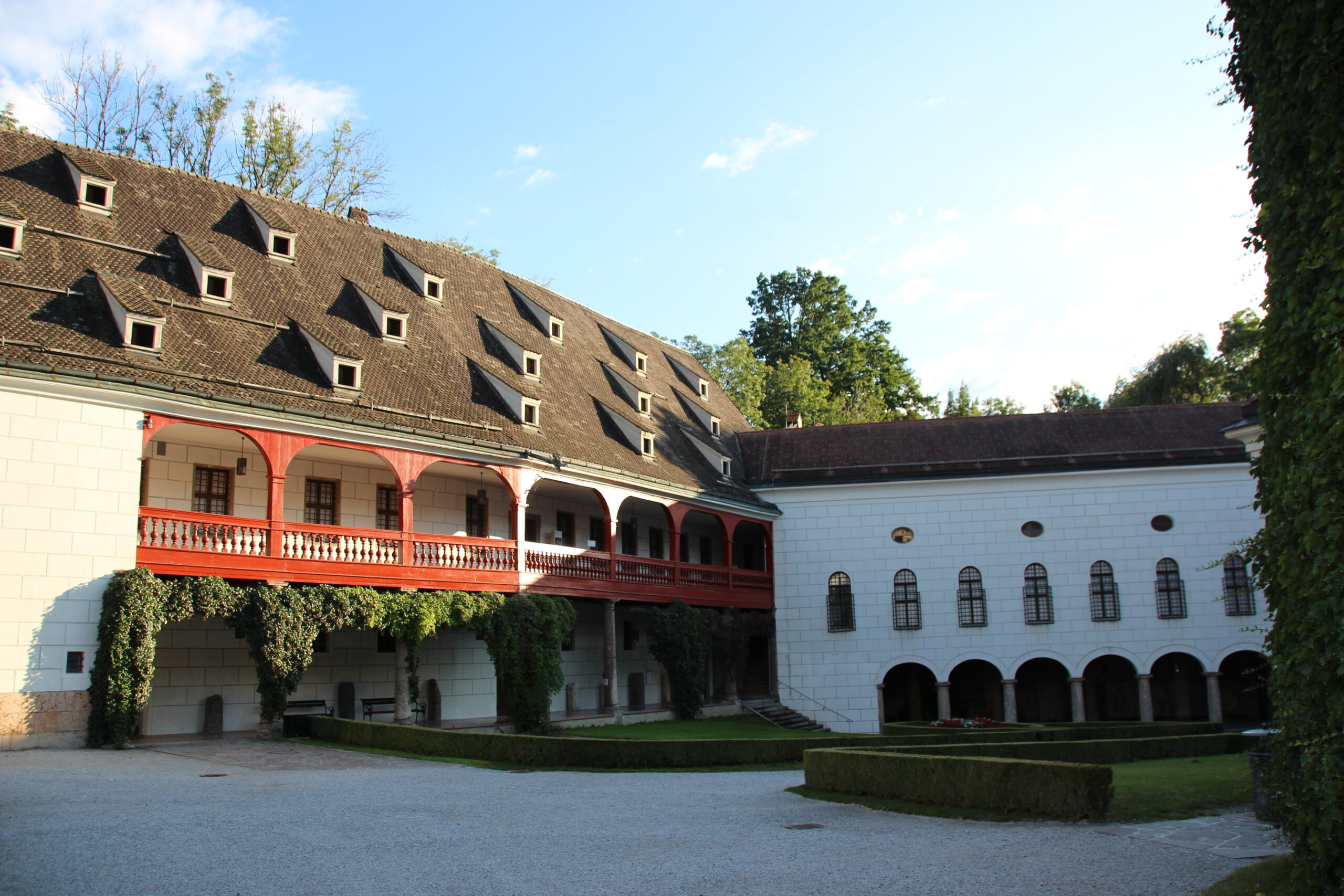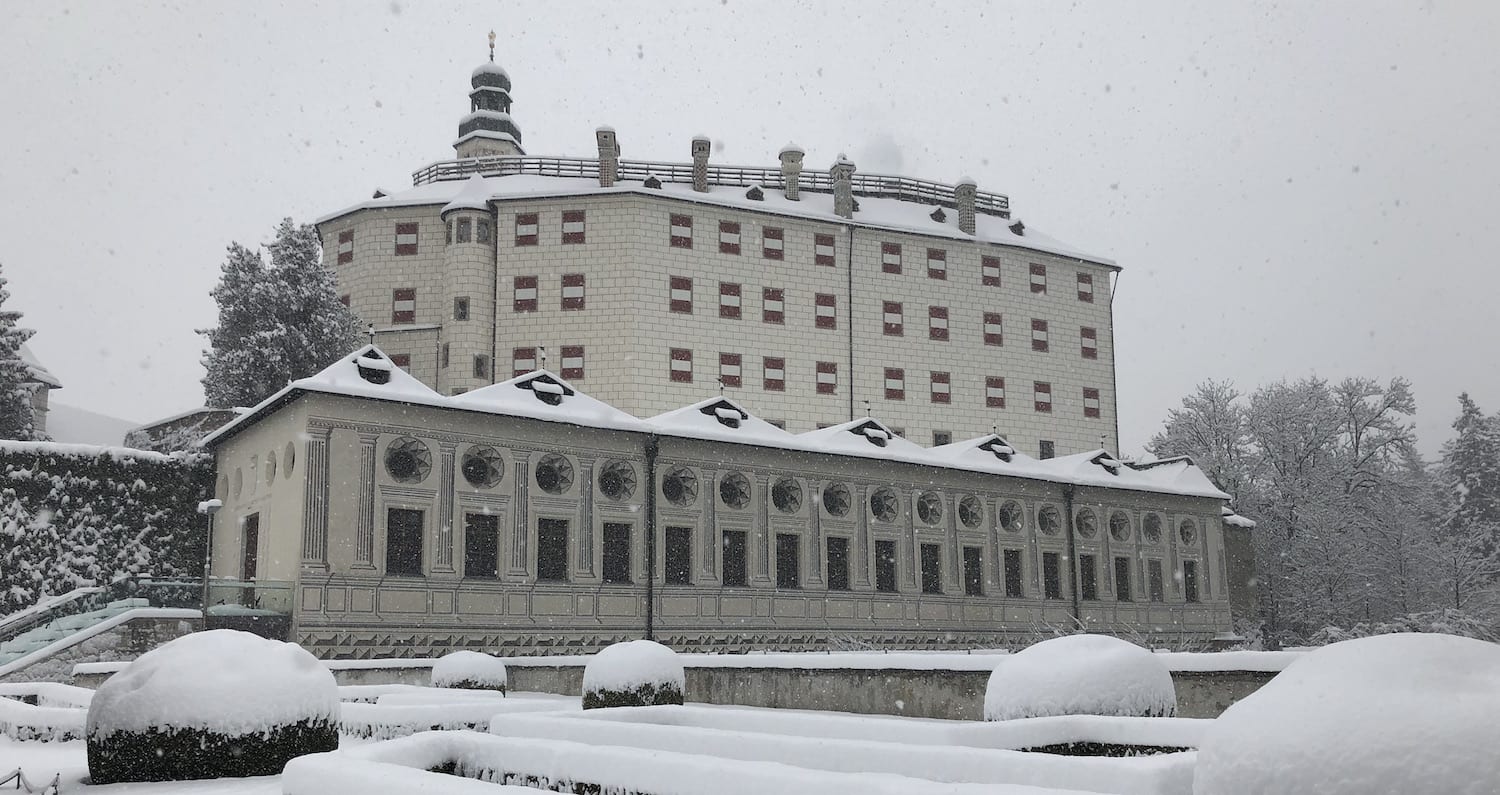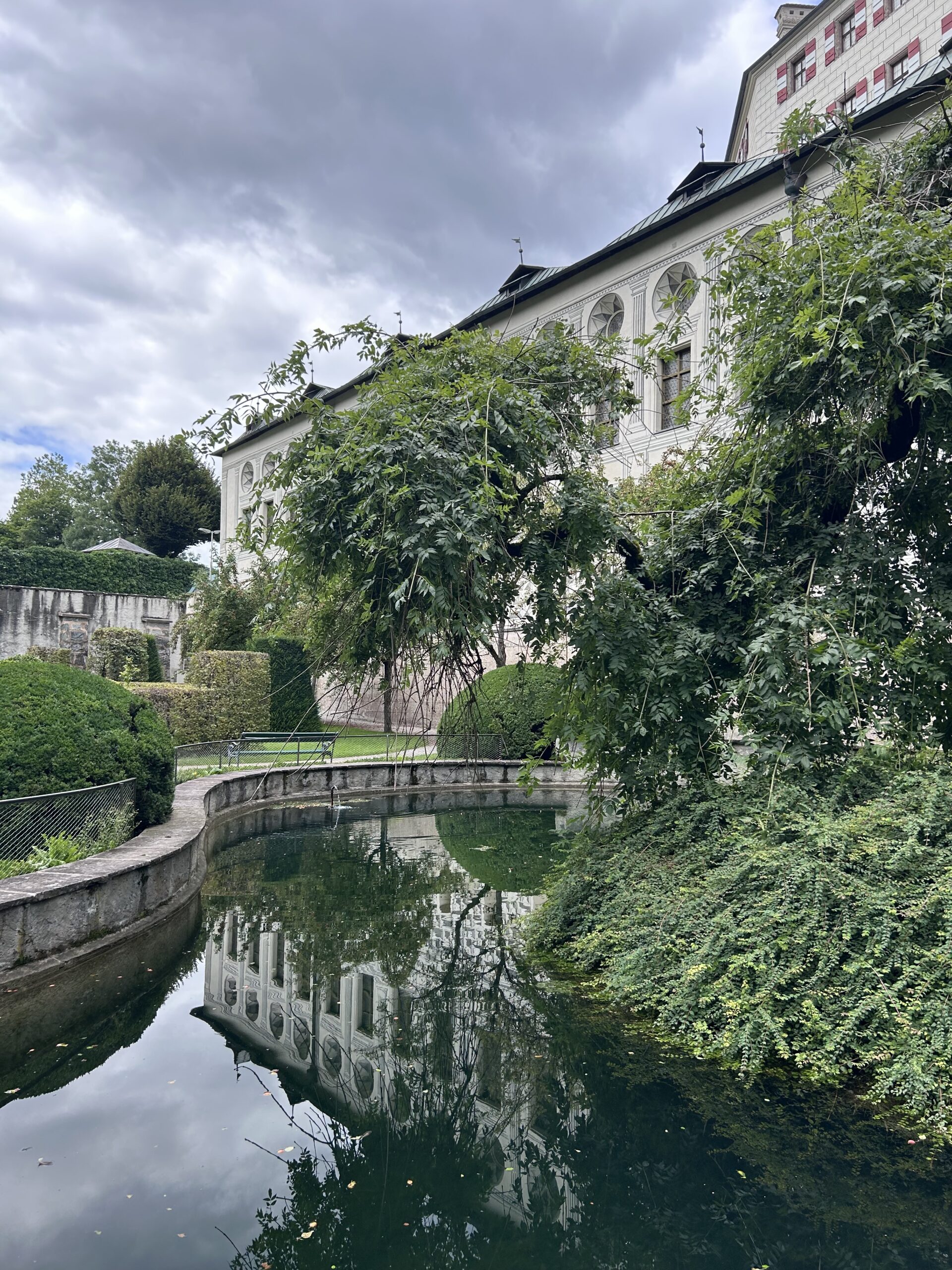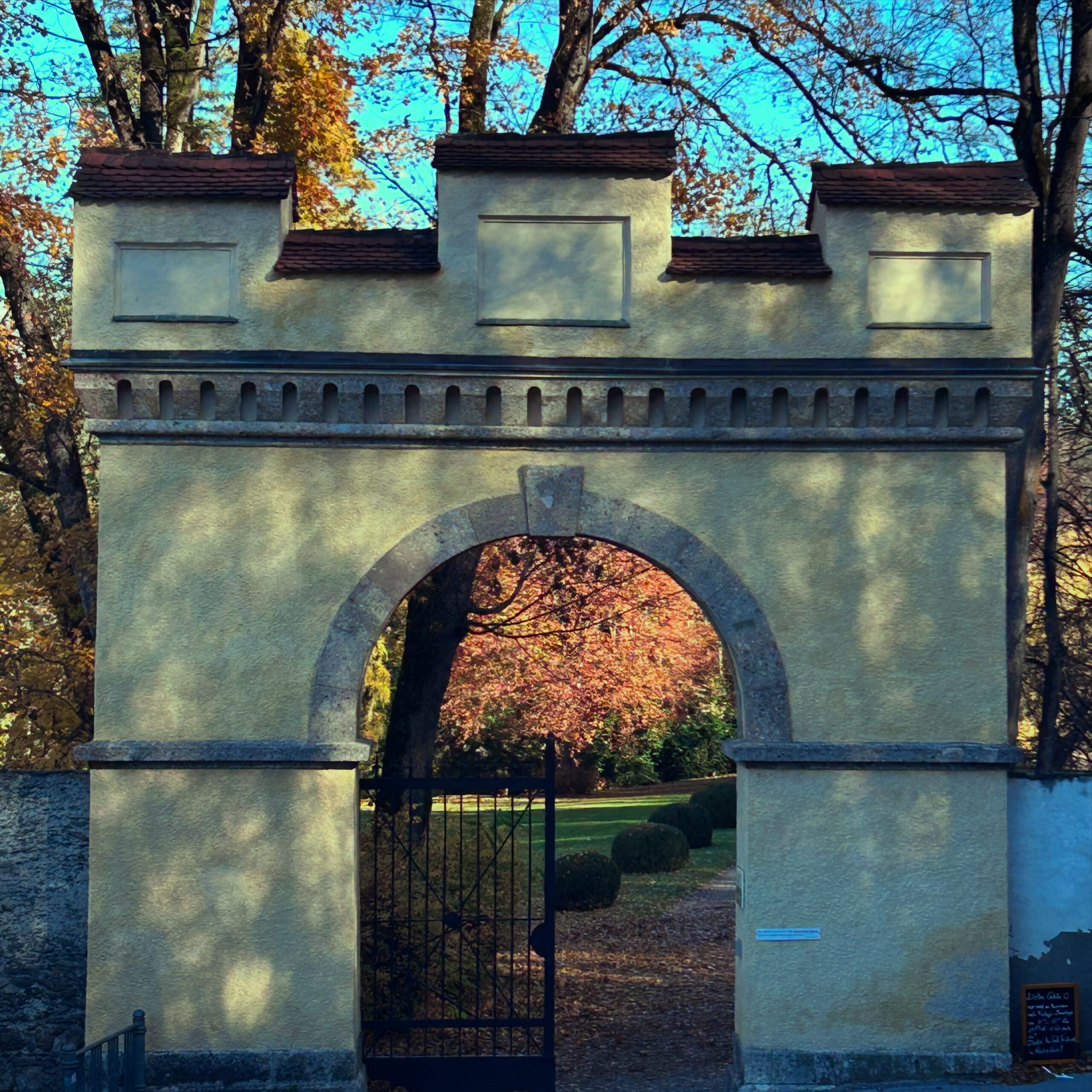Schloss Ambras
Schloßstraße 12-20
Worth knowing
Ambras Castle is the highlight of Renaissance culture in Innsbruck. In addition to a free tour of the large gardens, the highlights of a visit include the armoury and the still extensive collection of paintings, the inner courtyard, the magnificent Spanische Saal, Philippine Welser's bathroom and the richly decorated St Nicholas Chapel from the 19th century. The history of the castle stretches from the beginnings of Innsbruck to the 20th century. Even in the early Middle Ages, a fortification stood on the site of today's Ambras Castle. The Counts of Andechs had built a castle, which was destroyed in 1133 during a feud between Otto II of Andechs and Duke Henry the Proud of Bavaria as part of the investiture dispute between the Hohenstaufen and Guelph dynasties. The issue at stake was whether the pope or king were allowed to appoint bishops they trusted. The question was important for the Andechs, as they were dependent on the goodwill of the respective church leaders in order to retain their offices and fiefdoms.
In the 13th century, another castle was built on the ruins, which had little in common with today's castle. The Tyrolean prince Siegmund had the complex remodelled to make it more comfortable for his wife Katharina of Saxony. The transformation from a fortified complex to a residential castle began. His successor Maximilian mortgaged the castle to Wilhelm Schurff (1484 - 1556), the brother of his truchsess.
Under Maximilian's great-grandson Ferdinand II. Omeras was remodelled by court architect Lucchese into Ambras Castle in its present appearance. Innsbruck was to be in no way inferior to the princely courts of northern Italy that served as models in the Renaissance period. The fact that the prince was aware of the exorbitant building costs is shown by the inscription "Pretium laborum non vile" (The price of labour is not small) at the portal to the High Castle In 1564, Ferdinand had the High Castle, the Spanischen Saal and a palace garden. Together with his wife Philippine Welser, Ferdinand used the new complex as a residential palace. The residence was partly financed from the profits of the Welser family's colonial trading business, while the majority was contributed by the subjects through generously increased taxes.
Lavish parties were celebrated at the new court. Noble guests, often travelling through from the German lands to Italy, enjoyed his hospitality at Ambras Castle to the full. On average, almost 100 guests are said to have dined at court, looked after by 230 servants. A water-powered turntable to make the food easily accessible for the guests was the technical highlight of the furnishings. At great expense to himself and his guests, he organised lavish dinners at Ambras Castle. Mottoparties with costumes and feasts in the spirit of the Renaissance. At the Bacchanalien the members had to empty huge cups of wine in one go to imitate the participants in the ancient symposia. The Bacchusgrotte opposite the high castle is a reminder of this. The mechanical Catch chairThe toeholds of which only came loose after the guests had emptied their wine, and the accompanying drinking books with the names of the successful drinkers, were moved to Vienna.
In addition to carnal pleasures, people also indulged in the sports of the time. The nobility had the privilege of hunting at the discretion of the sovereign. After the law was changed under Maximilian I around 1500, hunting became a kind of sport. Hunting deer and chamois was mostly reserved for the high aristocracy. The lesser nobility were allowed to hunt rabbits, roe deer and other smaller animals. The terms "big game" and "small game" originate from this custom. The garden, including the impressive waterfall, was also laid out as the court's own hunting ground under Ferdinand. The prince and his guests could go hunting in Ambras Castle right outside the front door. Lustjagd which was usually crowned with success thanks to the uneven distribution of chances in the rather manageable garden.
Ferdinand housed his extensive art collection in the Lower Castle. The portraits, paintings, weapons, armour, musical instruments, as well as scientific research objects, early mechanical automata and astronomical devices, were considered one of the largest collections in Europe in the 16th century. In the spirit of the late Renaissance, Ferdinand wanted to do justice to the universal claim to knowledge. His collection also bears witness to the influence that Jesuit scholars had on him at court and in education. Objects from all over the world found their way to Innsbruck via the Habsburgs' colonial possessions and the Welser family's trade relations in South America and Asia. Together with the art collection of the French King Francis I, from which the Louvre was to emerge, the papal collections and the works publicly exhibited in Florence on the Piazza della Signoria With its many works of art on display, some of which can be admired today in the Uffizi Gallery, Ferdinand's art collection was one of the first exhibitions that could be described as a museum. Ambras Castle was probably unique in terms of the scope and diversity of its artefacts.
The castle park in its current form of an English landscape garden was laid out in the 19th century. A walk through the extensive grounds, laid out at different levels with bridges, waterfalls, a pond and peacocks, is very beautiful all year round. The castle underwent further renovation in 1859, during which parts were unfortunately treated rather carelessly. Some walls, rooms and frescoes were lost forever. In 1876, Johann Deininger, the later co-founder and first director of the k.k. Staatsgewerbeschule, today's HTL, was brought to Innsbruck as an expert to professionally manage the work and supervise the restoration of the Spanish Hall in Ambras Castle. Four years later, Ambras Castle was opened to the public as a museum under his aegis. Today the administration is the responsibility of the Kunsthistorisches Museum Vienna. The garden and museum are examples of the opening up of estates formerly reserved for the nobility. The violent revolution may not have taken place in Tyrol in 1848, but the bourgeois revolution took place in leisure behaviour. Places such as the Hofgarten and Ambras Castle, and later Mount Isel, were among the favourite destinations of Innsbruck residents for excursions and walks.
Ferdinand II: Principe and Renaissance prince
Archduke Ferdinand II of Austria (1529 - 1595) is one of the most colourful figures in Tyrolean history. His father, Emperor Ferdinand I, gave him an excellent education. He grew up at the Spanish court of his uncle Emperor Charles V. The years in which Ferdinand received his schooling were the early years of Jesuit influence at the Habsburg courts. The young statesman was brought up entirely in the spirit of pious humanism. This was complemented by the customs of the Renaissance aristocracy. At a young age, he travelled through Italy and Burgundy and had become acquainted with a lifestyle at the wealthy courts there that had not yet established itself among the German aristocracy. Ferdinand was what today would be described as a globetrotter, a member of the educated elite or a cosmopolitan. He was considered intelligent, charming and artistic. Among his less eccentric contemporaries, Ferdinand enjoyed a reputation as an immoral and hedonistic libertine. Even during his lifetime, he was rumoured to have organised debauched and immoral orgies.
Ferdinand's father divided his kingdom between his sons. Maximilian II, who was rightly suspected of heresy and adherence to Protestant doctrines by his parents, inherited Upper and Lower Austria as well as Bohemia and Hungary. Ferdinand's younger brother Charles ruled in Inner Austria, i.e. Carinthia, Styria and Carniola. The middle child received Tyrol, which at that time extended as far as the Engadine, and the fragmented Habsburg Forelands in the west of the central European possessions. Ferdinand took over the Tyrol as sovereign in turbulent times. He had already spent several years in Innsbruck in his youth. The mines in Schwaz began to become unprofitable due to the cheap silver from America. The flood of silver from the Habsburg possessions in New Spain on the other side of the Atlantic led to inflation.
However, these financial problems did not stop Ferdinand from commissioning personal and public infrastructure. Innsbruck benefited enormously, both economically and culturally, from the fact that after years without a sovereign prince, it was now once again the centre of a ruler. Ferdinand's archducal presence attracted the aristocracy and civil servants back to Innsbruck after the decades of neglect following Maximilian's death. By the late 1560s, the administration had grown back to 1000 people, who fuelled the local economy with their money. Bakers, butchers and inns flourished again after a few barren years. At the end of the 16th century, Innsbruck had an above-average number of innkeepers compared to other towns, who earned an above-average amount of money from merchants, guests and travellers passing through. Wine houses were not only inns, but also storage and trading centres.
The Italian cities of Florence, Venice and Milan were trendsetters in terms of culture, art and architecture. Ferdinand's Tyrolean court was to be in no way inferior to them. Gone were the days when Germans were considered uncivilised in the more beautiful cities south of the Alps, barbaric or even as Pigs were labelled. To this end, he had Innsbruck remodelled in the spirit of the Renaissance. In keeping with the trend of the time, he imitated the Italian aristocratic courts. Court architect Giovanni Lucchese assisted him in this endeavour. Ferdinand spent a considerable part of his life at Ambras Castle near Innsbruck, where he amassed one of the most valuable collections of works of art and armour in the world. Ferdinand transformed the castle above the village of Amras into a modern court. His parties, masked balls and parades were legendary. During the wedding of a nephew, he had 1800 calves and 130 oxen roasted. Wine is said to have flowed from the wells instead of water for 10 days.
But Ambras Castle was not the end of Innsbruck's transformation. To the west of the city, an archway still reminds us of the Tiergartena hunting ground for Ferdinand, including a summer house also designed by Lucchese. In order for the prince to reach his weekend residence, a road was laid in the marshy Höttinger Au, which formed the basis for today's Kranebitter Allee. The Lusthaus was replaced in 1786 by what is now known as the Pulverturm The new building, which houses part of the sports science faculty of the University of Innsbruck, replaced the well-known building. The princely sport of hunting was followed in the former Lusthauswhich was the Powder Tower. In the city centre, he had the princely Comedihaus on today's Rennweg. In order to improve Innsbruck's drinking water supply, the Mühlauerbrücke bridge was built under Ferdinand to lay a water pipeline from the Mühlaubach stream into the city centre. The Jesuits, who had arrived in Innsbruck shortly before Ferdinand took office to make life difficult for troublesome reformers and church critics and to reorganise the education system, were given a new church in Silbergasse. Numerous new buildings such as the Jesuit, Franciscan, Capuchin and Servite monasteries boosted trade and the construction industry.
The new religious orders supported Ferdinand's focus on the confessional orientation of his flock. In his Tyrolean provincial ordinance issued in 1573, he not only put a stop to fornication, swearing and prostitution, but also obliged his subjects to lead a God-fearing, i.e. Catholic, lifestyle. The „Prohibition of sorcery and disbelieving warfare" prohibited any deviation from the true faith on pain of imprisonment, corporal punishment and expropriation. Jews had to wear a clearly visible ring of yellow fabric on the left side of their chest at all times. At the same time, Ferdinand brought a Jewish financier to Innsbruck to handle the money transactions for the elaborate farm management. Samuel May and his family lived in the city as princely patronage Jews. Daniel Levi delighted Ferdinand with dancing and harp playing at the theatre and Elieser Lazarus looked after his health as court physician.
Fleecing the population, living in splendour, tolerating Protestantism among his important advisors and at the same time fighting Protestantism among the people was no contradiction for the trained Renaissance prince. Already at the age of 15, he marched under his uncle Charles V in the Schmalkaldic War into battle against the enemies of the Roman Church. As a sovereign, he saw himself as Advocatus Ecclesiae (note: representative of the church) in a confessional absolutist sense, who was responsible for the salvation of his subjects. Coercive measures, the foundation of churches and monasteries such as the Franciscans and the Capuchins in Innsbruck, improved pastoral care and the staging of Jesuit theatre plays such as "The beheading of John" were the weapons of choice against Protestantism. Ferdinand's piety was not artificial, but like most of his contemporaries, he managed to adapt flexibly to the situation.
Ferdinand's politics were suitably influenced by the Italian avant-garde of the time. Machiavelli wrote his work "Il Principe", which stated that rulers were allowed to do whatever was necessary for their success, even if they were incapable of being deposed. Ferdinand II attempted to do justice to this early absolutist style of leadership and issued his Tyrolean Provincial Code A modern set of legal rules by the standards of the time. For his subjects, this meant higher taxes on their earnings as well as extensive restrictions on mountain pastures, fishing and hunting rights. The miners, mining entrepreneurs and foreign trading companies with their offices in Innsbruck also drove up food prices. It could be summarised that Ferdinand enjoyed the exclusive pleasure of hunting on his estates, while his subjects lived at subsistence level due to increasing burdens, prices and game damage.
His relationship life was eccentric for a member of the high aristocracy. Ferdinand's first "semi-wild marriage" was to the commoner Philippine Welser. After his wife #1 died, Ferdinand married the devout Anna Caterina Gonzaga, a 16-year-old Princess of Mantua, at the age of 53. However, it seems that the two did not feel much affection for each other, especially as Anna Caterina was a niece of Ferdinand. The Habsburgs were less squeamish about marriages between relatives than they were about the marriage of a nobleman to a commoner. However, he was also "only" able to father three daughters with her. Ferdinand's final resting place was in the Silver Chapel with his first wife Philippine Welser.
Philippine Welser: Klein Venedig, Kochbücher und Kräuterkunde
Philippine Welser (1527 - 1580) was the wife of Archduke Ferdinand II and one of Innsbruck's most popular rulers. The Welsers were one of the wealthiest families of their time. Their uncle Bartholomäus Welser was similarly wealthy to Jakob Fugger and also came from the class of merchants and financiers who had acquired enormous wealth around 1500. The pillars of this wealth were the spice trade with India and the mining and metal trade with the American colonies. Welser had also granted loans to the Habsburgs. Instead of paying off the loans, Emperor Charles V pledged some of the newly annexed lands in America to the Welser family, who in return received the land as a colony. Klein-VenedigVenezuela, with fortresses and settlements. They organised expeditions to discover the legendary land of gold El Dorado to discover. In order to get as much as possible out of their fiefdom, they established trading posts to participate in the profitable transatlantic slave trade between Europe, West Africa and America. Although Charles V prohibited trade with indigenous people from South Africa after 1530, the use of African slaves on the plantations and in the mines was not covered by this regulation. The brutal behaviour of the Welser led to complaints at the imperial court in 1546, where they were denied the fiefdom for Klein-Venedig was subsequently withdrawn. However, their trade relations remained intact.
Ferdinand and Philippine met at a carnival ball in Pilsen. The Habsburg fell head over heels in love with the wealthy woman from Augsburg and married her. Nobody in the House of Habsburg was particularly pleased about the couple's secret marriage, even though the business relationships between the aristocrats and the newly rich Augsburg merchants were already several decades old and the Welser's money could be put to good use. Marriages between commoners and aristocrats were considered scandalous and not befitting their status, despite their wealth. The Tyrolean prince is said to have been infatuated with his beautiful wife all his life, which is why he disregarded all conventions of the time. The emperor only recognised the marriage after the couple had asked for forgiveness for their marriage and pledged themselves to eternal secrecy. The children of the morganatic marriage were therefore excluded from the succession. Philippine was considered extremely beautiful. According to contemporary witnesses, her skin was so delicate that „man hätte einen Schluck Rotwein durch ihre Kehle fließen sehen können“. Ferdinand had Ambras Castle remodelled into its present form for his wife. His brother Maximilian even said that "Ferdinand verzaubert sai" by the beautiful Philippine Welser when Ferdinand withdrew his troops during the Turkish war to go home to his wife. The epilogue is less flattering "...I wanted the brekin to be in a sakh and what not. God forgive me."
Philippine Welser's passion was cooking. There is still a collection of recipes in the Austrian National Library today. In the Middle Ages and early modern times, the art of cookery was practised exclusively by the wealthy and aristocrats, while the vast majority of subjects had to eat whatever was available. The Middle Ages and modern times, in fact all people up until the 1950s, lived with a permanent lack of calories. Whereas today we eat too much and get ill as a result, our ancestors suffered from illnesses caused by malnutrition. Fruit was just as rare on the menu as meat. The food was monotonous and hardly flavoured. Spices such as exotic pepper were luxury goods that ordinary people could not afford. While the diet of the ordinary citizen was a dull affair, where the main aim was to get the calories for the daily work as efficiently as possible, the attitude towards food and drink began to change in Innsbruck under Ferdinand II and Philippine Welser. The court had contributed to a certain cultivation of manners and customs in Innsbruck since Frederick IV, and Philippine Welser and Ferdinand took this development to the extreme at Ambras Castle and Weiherburg Castle. The banquets they organised were legendary and often degenerated into orgies.
Herbalism was her second hobbyhorse. Philippine Welser described how to use plants and herbs to alleviate physical ailments of all kinds. "To whiten and freshen the teeth and kill the worms in them: Take rosemary wood and burn it to charcoal, crush it all to powder, bind it in a silken cloth and rub the teeth with itwas one of her tips for a healthy and cultivated existence. She had a herb garden created at Ambras Castle in Innsbruck for her hobby and her studies.
According to reports of the time, she was very popular among the Tyrolean population, as she took great care of the poor and needy. The care of the needy, led by the town council and sponsored by wealthy citizens and aristocrats, was not a speciality at the time, but common practice. Closer to salvation in the next life than through Christian charity, Caritasyou could not come.
, konnte man nicht kommen. Ihre letzte Ruhe fand Philippine Welser nach ihrem Tod 1580 in der Silbernen Kapelle in der Innsbrucker Hofkirche. Gemeinsam mit ihren als Säugling verstorbenen Kindern und Ferdinand wurde sie dort begraben. Unterhalb des Schloss Ambras erinnert die Philippine-Welser-Straße an sie.
Innsbruck and the House of Habsburg
Today, Innsbruck's city centre is characterised by buildings and monuments that commemorate the Habsburg family. For many centuries, the Habsburgs were a European ruling dynasty whose sphere of influence included a wide variety of territories. At the zenith of their power, they were the rulers of a "Reich, in dem die Sonne nie untergeht". Through wars and skilful marriage and power politics, they sat at the levers of power between South America and the Ukraine in various eras. Innsbruck was repeatedly the centre of power for this dynasty. The relationship was particularly intense between the 15th and 17th centuries. Due to its strategically favourable location between the Italian cities and German centres such as Augsburg and Regensburg, Innsbruck was given a special place in the empire at the latest after its elevation to a royal seat under Emperor Maximilian.
Tyrol was a province and, as a conservative region, usually favoured the dynasty. Even after its time as a royal seat, the birth of new children of the ruling family was celebrated with parades and processions, deaths were mourned in memorial masses and archdukes, kings and emperors were immortalised in public spaces with statues and pictures. The Habsburgs also valued the loyalty of their Alpine subjects to the Nibelung. In the 19th century, the Jesuit Hartmann Grisar wrote the following about the celebrations to mark the birth of Archduke Leopold in 1716:
„But what an imposing sight it was when, as night fell, the Abbot of Wilten held the final religious function in front of St Anne's Column, which had been consecrated by the blood of the country, surrounded by rows of students and the packed crowd; when, by the light of thousands of burning lights and torches, the whole town, together with the studying youth, the hope of the country, implored heaven for a blessing for the Emperor's newborn first son.“
Its inaccessible location made it the perfect refuge in troubled and crisis-ridden times. Charles V (1500 - 1558) fled during a conflict with the Protestant Schmalkaldischen Bund to Innsbruck for some time. Ferdinand I (1793 - 1875) allowed his family to stay in Innsbruck, far away from the Ottoman threat in eastern Austria. Shortly before his coronation in the turbulent summer of the 1848 revolution, Franz Josef I enjoyed the seclusion of Innsbruck together with his brother Maximilian, who was later shot by insurgent nationalists as Emperor of Mexico. A plaque at the Alpengasthof Heiligwasser above Igls reminds us that the monarch spent the night here as part of his ascent of the Patscherkofel. Some of the Tyrolean sovereigns from the House of Habsburg had no special relationship with Tyrol, nor did they have any particular affection for this German land. Ferdinand I (1503 - 1564) was educated at the Spanish court. Maximilian's grandson Charles V had grown up in Burgundy. When he set foot on Spanish soil for the first time at the age of 17 to take over his mother Joan's inheritance of the kingdoms of Castile and Aragon, he did not speak a word of Spanish. When he was elected German Emperor in 1519, he did not speak a word of German.
Not all Habsburgs were happy to be „allowed“ to be in Innsbruck. Married princes and princesses such as Maximilian's second wife Bianca Maria Sforza or Ferdinand II's second wife Anna Caterina Gonzaga were stranded in the harsh, German-speaking mountains after the wedding without being asked. If you also imagine what a move and marriage from Italy to Tyrol to a foreign man meant for a teenager, you can imagine how difficult life was for the princesses. Until the 20th century, children of the aristocracy were primarily brought up to be politically married. There was no opposition to this. One might imagine courtly life to be ostentatious, but privacy was not provided for in all this luxury.
Innsbruck experienced its Habsburg heyday when the city was the main residence of the Tyrolean sovereigns. Ferdinand II, Maximilian III and Leopold V and their wives left their mark on the city during their reigns. When Sigismund Franz von Habsburg (1630 - 1665) died childless as the last sovereign prince, the title of residence city was also history and Tyrol was ruled by a governor. Tyrolean mining had lost its importance and did not require any special attention. Shortly afterwards, the Habsburgs lost their possessions in Western Europe along with Spain and Burgundy, which moved Innsbruck from the centre to the periphery of the empire. In the Austro-Hungarian Monarchy of the 19th century, Innsbruck was the western outpost of a huge empire that stretched as far as today's Ukraine. Franz Josef I (1830 - 1916) ruled over a multi-ethnic empire between 1848 and 1916. However, his neo-absolutist concept of rule was out of date. Although Austria had had a parliament and a constitution since 1867, the emperor regarded this government as "his". Ministers were responsible to the emperor, who was above the government. In the second half of the 19th century, the ailing empire collapsed. On 28 October 1918, the Republic of Czechoslovakia was proclaimed, and on 29 October, Croats, Slovenes and Serbs left the monarchy. The last Emperor Charles abdicated on 11 November. On 12 November, "Deutschösterreich zur demokratischen Republik, in der alle Gewalt vom Volke ausgeht“. The chapter of the Habsburgs was over.
Despite all the national, economic and democratic problems that existed in the multi-ethnic states that were subject to the Habsburgs in various compositions and forms, the subsequent nation states were sometimes much less successful in reconciling the interests of minorities and cultural differences within their territories. Since the eastward enlargement of the EU, the Habsburg monarchy has been seen by some well-meaning historians as a pre-modern predecessor of the European Union. Together with the Catholic Church, the Habsburgs shaped the public sphere through architecture, art and culture. Goldenes DachlThe Hofburg, the Triumphal Gate, Ambras Castle, the Leopold Fountain and many other buildings still remind us of the presence of the most important ruling dynasty in European history in Innsbruck.
The Counts of Andechs and the foundation of Innsbruck
The 12th century brought an economic, scientific and social boom to Europe and is regarded as a kind of early medieval renaissance. Via the Crusades, there was an increased exchange with the cultures of the Middle East, which were more developed in many respects. Arab scholars brought translations of Greek thinkers such as Aristotle to Europe via southern Spain and Italy. Roman law was rediscovered at the first universities south of the Alps. New agricultural knowledge and a favourable climate, which was to last until the middle of the 14th century, made it possible for towns and larger settlements to emerge. One of these settlements was located to the north of Wilten Abbey between the River Inn and the Nordkette mountain range.
Politically and economically, the importance of the Inn Valley and the area north of it was mainly limited to transit. Tyrol had two low Alpine crossings, the Reschen Pass and the Brenner Pass, which were important for the imperial connection between the German lands in the north and the lands in Italy. In 1024, the Salian Conrad II, a rival of the Bavarian dukes from the House of Wittelsbach, was elected king. In order to bring these two Alpine crossings away from his Bavarian rivals and under the control of the Imperial Church, which was loyal to him, Conrad II granted the territory of Tyrol as a fief to the bishops of Brixen and Trento in 1027. The bishops in turn needed so-called bailiffs to administer these lands and administer justice.
These bailiffs of the Bishop of Brixen were the Counts of Andechs. The Andechs family may be overshadowed today by the Guelphs, Hohenstaufen, Wittelsbach and Habsburg dynasties, but they were an influential family in the High Middle Ages. They came from the area around Lake Ammer in Bavaria and owned estates in Upper Bavaria between the Lech and Isar rivers and east of Munich. Through skilful marriage politics, they had acquired the titles of Dukes of Merania, a region on the Dalmatian coast, and Margraves of Istria. They thus rose in rank within the Heiligen Römischen Reiches on. In the 12th century, they founded the Dießen monastery and the monastery on the holy mountain of Andechs above Lake Ammersee to ensure both administration and later salvation. In 1165, Otto V of Andechs came to the bishop's see in Brixen and gave the bailiwick over this high monastery to his brother. From then on, they administered the central part of the Inn Valley, the Wipp Valley, the Puster Valley and the Eisack Valley.
Today, Innsbruck stretches along both sides of the Inn. In the 12th century, this area was under the influence of two lords of the manor. South of the Inn, Wilten Abbey exercised lordship. The area north of the river was under the administration of the Andechs. While the southern urban area around the monastery had been used for agriculture for centuries, the alluvial area of the unregulated watercourse could not be cultivated before the High Middle Ages and was sparsely populated. The Inn Valley was densely forested and the banks of the wide Inn were swampy. Most of the people worked in agriculture, which was run by their landlord. They lived in poor huts made of mud and wood. There was hardly any medical care outside the towns, infant mortality was high and hardly anyone lived past the age of 50. Around the year 1133, the Andechs founded the market in what is now St Nicholas' Square Anbruggen and connected the northern and southern banks of the Inn via a bridge. The construction of the bridge turned the unusable agricultural land at the foot of the Nordkette mountain range into a trading centre. It greatly facilitated the movement of goods in the Eastern Alps. The Brenner route had become more interesting thanks to one of the innovations of the medieval Renaissance: new harnesses made it possible to negotiate the steep climbs with carts. The shorter Via Raetia had the Via Claudia Augusta over the Reschen Pass as the main transport route across the Alps. The customs revenue generated from trade between the German and Italian towns allowed the settlement to prosper. Blacksmiths, innkeepers, carriage operators, tailors, carpenters, rope makers, wagon makers and tanners settled in the small market. Horses, traders and carters had to be looked after and accommodated, and carts had to be repaired. The larger of these businesses employed clerks and farm labourers. The transformation from pure agriculture to a town began.
Anbruggen grew rapidly, but the space between the Nordkette and the Inn was limited. In 1180, Berchtold V of Andechs acquired a piece of land on the south side of the Inn from Wilten Monastery. This was the definitive starting signal for the genesis of Innsbruck. The abbot did not want to take his foot out of the door completely, as the new settlement developed splendidly thanks to the customs revenue. The document mentions three houses that were reserved for Wilten Abbey within the new settlement. In the course of building the town wall, the Counts of Andechs had the Andechs Castle and moved their ancestral seat from Merano to Innsbruck. Sometime between 1187 and 1204, the citizens of Innsbruck were granted city rights. The official date of foundation is often taken as 1239, when the last count of the Andechs dynasty, Otto VIII, formally confirmed the city charter in a document. Innsbruck was already the mint of the Andechs at this time and would probably have become the capital of their principality. But things turned out differently. In 1246, the Bavarian Wittelsbach dynasty, the Andechs' biggest rivals in southern Germany, destroyed their ancestral castle on Lake Ammersee. Otto, the last count of the House of Andechs-Merania, died without descendants in 1248. 12 years earlier, he had married Elisabeth, the daughter of Count Albert VIII of Tyrol. This noble family with its ancestral castle in Merano thus took over the fiefs and parts of the possessions, including the town on the Inn, as well as the arch-enemy with the Bavarian Wittelsbachs.
March 1848... and what it brought
The year 1848 occupies a mythical place in European history. Although the hotspots were not to be found in secluded Tyrol, but in the major metropolises such as Paris, Vienna, Budapest, Milan and Berlin, even in the Holy Land however, the revolutionary year left its mark. In contrast to the rural surroundings, an enlightened educated middle class had developed in Innsbruck. Enlightened people no longer wanted to be subjects of a monarch or sovereign, but citizens with rights and duties towards the state. Students and freelancers demanded political participation, freedom of the press and civil rights. Workers demanded better wages and working conditions. Radical liberals and nationalists in particular even questioned the omnipotence of the church.
In March 1848, this socially and politically highly explosive mixture erupted in riots in many European cities. In Innsbruck, students and professors celebrated the newly enacted freedom of the press with a torchlight procession. On the whole, however, the revolution proceeded calmly in the leisurely Tyrol. It would be foolhardy to speak of a spontaneous outburst of emotion; the date of the procession was postponed from 20 to 21 March due to bad weather. There were hardly any anti-Habsburg riots or attacks; a stray stone thrown into a Jesuit window was one of the highlights of the Alpine version of the 1848 revolution. The students even helped the city magistrate to monitor public order in order to show their gratitude to the monarch for the newly granted freedoms and their loyalty.
The initial enthusiasm for bourgeois revolution was quickly replaced by German nationalist, patriotic fervour in Innsbruck. On 6 April 1848, the German flag was waved by the governor of Tyrol during a ceremonial procession. A German flag was also raised on the city tower. Tricolour was hoisted. While students, workers, liberal-nationalist-minded citizens, republicans, supporters of a constitutional monarchy and Catholic conservatives disagreed on social issues such as freedom of the press, they shared a dislike of the Italian independence movement that had spread from Piedmont and Milan to northern Italy. Innsbruck students and marksmen marched to Trentino with the support of the k.k. The Innsbruck students and riflemen moved into Trentino to nip the unrest and uprisings in the bud. Well-known members of this corps were Father Haspinger, who had already fought with Andreas Hofer in 1809, and Adolf Pichler. Johann Nepomuk Mahl-Schedl, wealthy owner of Büchsenhausen Castle, even equipped his own company with which he marched across the Brenner Pass to secure the border.
The city of Innsbruck, as the political and economic centre of the multinational crown land of Tyrol and home to many Italian speakers, also became the arena of this nationality conflict. Combined with copious amounts of alcohol, anti-Italian sentiment in Innsbruck posed more of a threat to public order than civil liberties. A quarrel between a German-speaking craftsman and an Italian-speaking Ladin got so heated that it almost led to a pogrom against the numerous businesses and restaurants owned by Italian-speaking Tyroleans.
The relative tranquillity of Innsbruck suited the imperial house, which was under pressure. When things did not stop boiling in Vienna even after March, Emperor Ferdinand fled to Tyrol in May. According to press reports from this time, he was received enthusiastically by the population.
"Wie heißt das Land, dem solche Ehre zu Theil wird, wer ist das Volk, das ein solches Vertrauen genießt in dieser verhängnißvollen Zeit? Stützt sich die Ruhe und Sicherheit hier bloß auf die Sage aus alter Zeit, oder liegt auch in der Gegenwart ein Grund, auf dem man bauen kann, den der Wind nicht weg bläst, und der Sturm nicht erschüttert? Dieses Alipenland heißt Tirol, gefällts dir wohl? Ja, das tirolische Volk allein bewährt in der Mitte des aufgewühlten Europa die Ehrfurcht und Treue, den Muth und die Kraft für sein angestammtes Regentenhaus, während ringsum Auflehnung, Widerspruch. Trotz und Forderung, häufig sogar Aufruhr und Umsturz toben; Tirol allein hält fest ohne Wanken an Sitte und Gehorsam, auf Religion, Wahrheit und Recht, während anderwärts die Frechheit und Lüge, der Wahnsinn und die Leidenschaften herrschen anstatt folgen wollen. Und während im großen Kaiserreiche sich die Bande überall lockern, oder gar zu lösen drohen; wo die Willkühr, von den Begierden getrieben, Gesetze umstürzt, offenen Aufruhr predigt, täglich mit neuen Forderungen losgeht; eigenmächtig ephemere- wie das Wetter wechselnde Einrichtungen schafft; während Wien, die alte sonst so friedliche Kaiserstadt, sich von der erhitzten Phantasie der Jugend lenken und gängeln läßt, und die Räthe des Reichs auf eine schmähliche Weise behandelt, nach Laune beliebig, und mit jakobinischer Anmaßung, über alle Provinzen verfügend, absetzt und anstellt, ja sogar ohne Ehrfurcht, den Kaiaer mit Sturm-Petitionen verfolgt; während jetzt von allen Seiten her Deputationen mit Ergebenheits-Addressen mit Bittgesuchen und Loyalitätsversicherungen dem Kaiser nach Innsbruck folgen, steht Tirol ganz ruhig, gleich einer stillen Insel, mitten im brausenden Meeressturme, und des kleinen Völkchens treue Brust bildet, wie seine Berge und Felsen, eine feste Mauer in Gesetz und Ordnung, für den Kaiser und das Vaterland."
In June, a young Franz Josef, not yet emperor at the time, also stayed at the Hofburg on his way back from the battlefields of northern Italy instead of travelling directly to Vienna. Innsbruck was once again the royal seat, if only for one summer. While blood was flowing in Vienna, Milan and Budapest, the imperial family enjoyed life in the Tyrolean countryside. Ferdinand, Franz Karl, his wife Sophie and Franz Josef received guests from foreign royal courts and were chauffeured in four-in-hand carriages to the region's excursion destinations such as Weiherburg Castle, Stefansbrücke Bridge, Kranebitten and high up to Heiligwasser. A little later, however, the cosy atmosphere came to an end. Under gentle pressure, Ferdinand, who was no longer considered fit for office, passed the torch of regency to Franz Josef I. In July 1848, the first parliamentary session was held in the Court Riding School in Vienna. The first constitution was enacted. However, the monarchy's desire for reform quickly waned. The new parliament was an imperial council, it could not pass any binding laws, the emperor never attended it during his lifetime and did not understand why the Danube Monarchy, as a divinely appointed monarchy, needed this council.
Nevertheless, the liberalisation that had been gently set in motion took its course in the cities. Innsbruck was given the status of a town with its own statute. Innsbruck's municipal law provided for a right of citizenship that was linked to ownership or the payment of taxes, but legally guaranteed certain rights to members of the community. Birthright citizenship could be acquired by birth, marriage or extraordinary conferment and at least gave male adults the right to vote at municipal level. If you got into financial difficulties, you had the right to basic support from the town.
Thanks to the census-based majority voting system, the Greater German liberal faction prevailed within the city government, in which merchants, tradesmen, industrialists and innkeepers set the tone. On 2 June 1848, the first edition of the liberal and Greater German-minded Innsbrucker Zeitungfrom which the above article on the emperor's arrival in Innsbruck is taken. Conservatives, on the other hand, read the Volksblatt for Tyrol and Vorarlberg. Moderate readers who favoured a constitutional monarchy preferred to consume the Bothen for Tyrol and Vorarlberg. However, the freedom of the press soon came to an end. The previously abolished censorship was reintroduced in parts. Newspaper publishers had to undergo some harassment by the authorities. Newspapers were not allowed to write against the state government, monarchy or church.
"Anyone who, by means of printed matter, incites, instigates or attempts to incite others to take action which would bring about the violent separation of a part from the unified state... of the Austrian Empire... or the general Austrian Imperial Diet or the provincial assemblies of the individual crown lands.... Imperial Diet or the Diet of the individual Crown Lands... violently disrupts... shall be punished with severe imprisonment of two to ten years."
After Innsbruck officially replaced Meran as the provincial capital in 1849 and thus finally became the political centre of Tyrol, political parties were formed. From 1868, the liberal and Greater German orientated party provided the mayor of the city of Innsbruck. The influence of the church declined in Innsbruck in contrast to the surrounding communities. Individualism, capitalism, nationalism and consumerism stepped into the breach. New worlds of work, department stores, theatres, cafés and dance halls did not supplant religion in the city either, but the emphasis changed as a result of the civil liberties won in 1848.
Perhaps the most important change to the law was the Basic relief patent. In Innsbruck, the clergy, above all Wilten Abbey, held a large proportion of the peasant land. The church and nobility were not subject to taxation. In 1848/49, manorial rule and servitude were abolished in Austria. Land rents, tithes and roboters were thus abolished. The landlords received one third of the value of their land from the state as part of the land relief, one third was regarded as tax relief and the farmers had to pay one third of the relief themselves. They could pay off this amount in instalments over a period of twenty years.
The after-effects can still be felt today. The descendants of the then successful farmers enjoy the fruits of prosperity through inherited land ownership, which can be traced back to the land relief of 1848, as well as political influence through land sales for housing construction, leases and public sector redemptions for infrastructure projects. The land-owning nobles of the past had to resign themselves to the ignominy of pursuing middle-class labour. The transition from birthright to privileged status within society was often successful thanks to financial means, networks and education. Many of Innsbruck's academic dynasties began in the decades after 1848.
Das bis dato unbekannte Phänomen der Freizeit kam, wenn auch für den größten Teil nur spärlich, auf und begünstigte gemeinsam mit frei verfügbarem Einkommen einer größeren Anzahl an Menschen Hobbies. Zivile Organisationen und Vereine, vom Lesezirkel über Sängerbünde, Feuerwehren und Sportvereine, gründeten sich. Auch im Stadtbild manifestierte sich das Revolutionsjahr. Parks wie der Englische Garten beim Schloss Ambras oder der Hofgarten waren nicht mehr exklusiv der Aristokratie vorbehalten, sondern dienten den Bürgern als Naherholungsgebiete vom beengten Dasein. In St. Nikolaus entstand der Waltherpark als kleine Ruheoase. Einen Stock höher eröffnete im Schloss Büchsenhausen Tirols erste Schwimm- und Badeanstalt, wenig später folgte ein weiteres Bad in Dreiheiligen. Ausflugsgasthöfe rund um Innsbruck florierten. Neben den gehobenen Restaurants und Hotels entstand eine Szene aus Gastwirtschaften, in denen sich auch Arbeiter und Angestellte gemütliche Abende bei Theater, Musik und Tanz leisten konnten.
